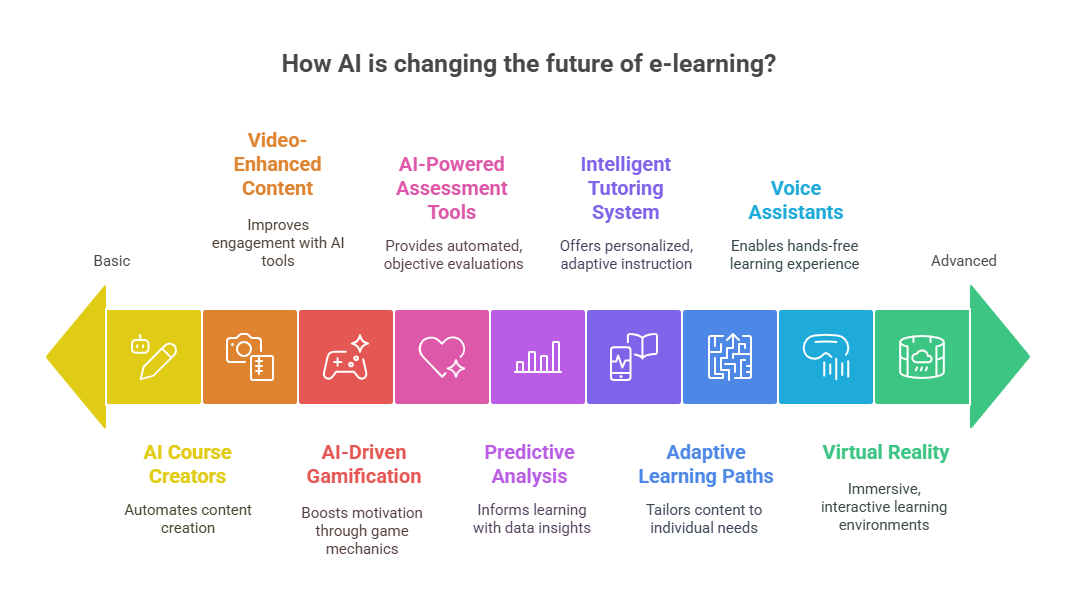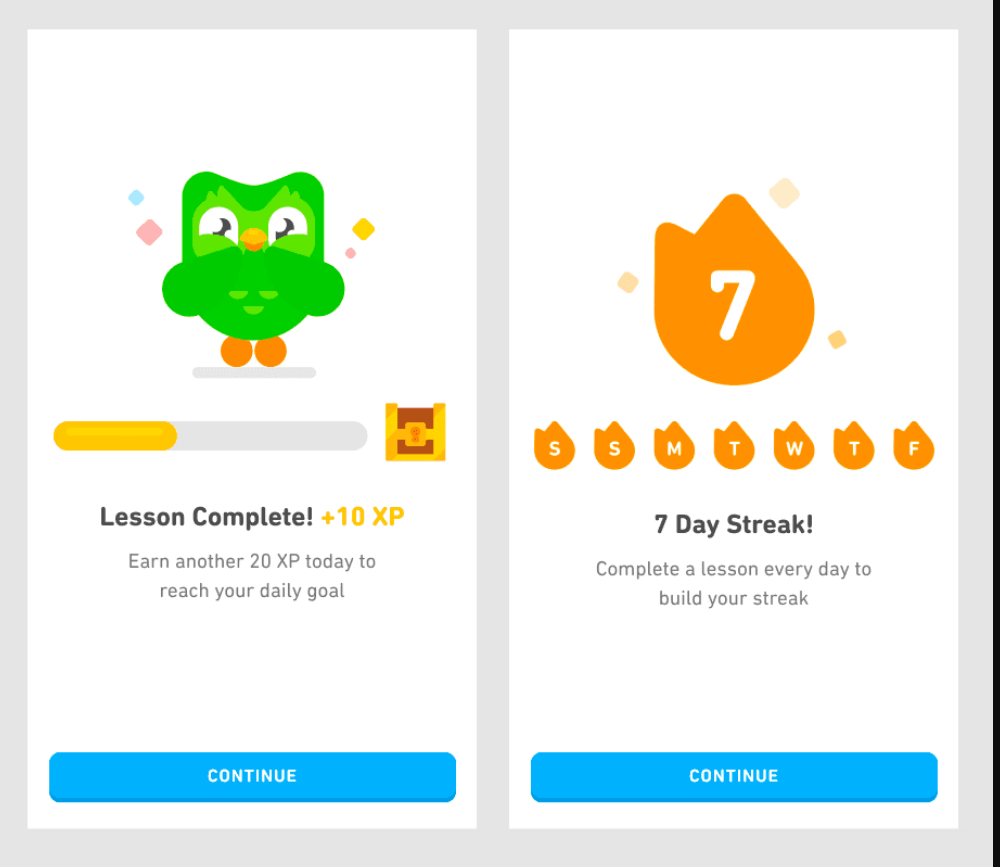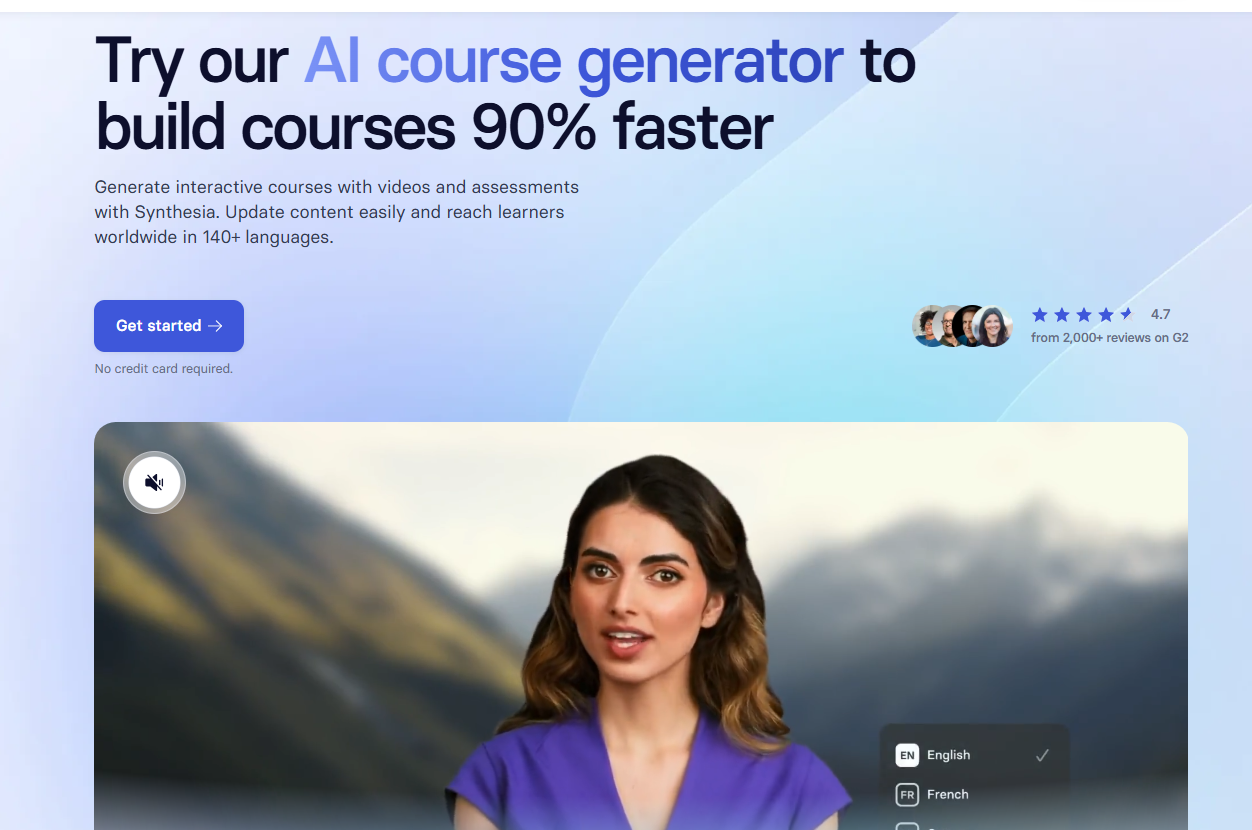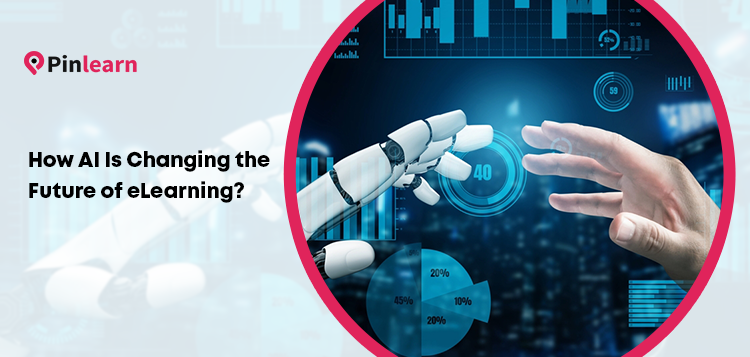How AI Is Changing the Future of E-Learning?
The advent of AI in e-learning has revolutionized the education industry. Today, you can create a full-fledged course from a single prompt. Or create stunning videos from text with an AI avatar.
AI integration has made e-learning more personalized, effective, and quick. E-learning apps like Duolingo and Memrise are actively embracing AI as core elements. From real-time feedback on language fluency to adaptive quizzes, learning has never been more fun!
Educators can now master the art of teaching, saving hours on course creation. Let’s take a closer look at how AI trends are enriching the learning experience!
Key Takeaways:
- The AI market in e-learning is poised to reach $32.27 billion from $5.88 billion by 2030.
- Personalised learning paths, ITS, gamification, virtual assistants, and predictive analytics are among the top e-learning trends.
- Hyper-personalization involves flexible learning paths based on patterns and trends in learner behaviour.
- VR and AR immerses learners with simulations for better retention.
- AI-powered tools accelerate the creation of videos, voiceovers, interactive quizzes, and more.
The Role of AI in E-Learning
AI is revolutionizing e-learning with better e-learning experience for students and educators. Amidst the generative AI revolution, the impact of AI in e-learning cannot be neglected.
The global AI market in e-learning is expected to reach $32.27 billion by 2030.
So, what is catalyzing the growth?
Schools and educational institutions are embracing Intelligent Tutoring Systems(ITS), chatbots, and course creation tools.
Further natural language processing and AI-based analytics for assessments and adaptive learning are other growth drivers. AI can now personalize your learning experience with learning style, overall progress, and preferences.
As AI algorithms are getting smarter, learner behaviour is becoming more predictable. These systems can understand learners’ strengths and shortfalls and tailor learning experiences. Thus, AI is transforming learning into an engaging, flexible, and accessible experience.
9 Ways AI is Reshaping E-learning Experience
Let’s look at the top trends transforming the e-learning industry!

1. Adaptive Learning Paths
AI’s potential to script personalized learning paths catering to learner needs, behaviour, and performance is remarkable. This is driving a shift from the one-size-fits-all approach to a more dynamic, adaptive approach.
A classroom is a diverse pool of students with different backgrounds, learning styles, and even special needs. Each learner has unique skills and their own pace and with different methods.
For example, some are visual learners, while others learn better through auditory techniques. And others learn from real-world or practical experiences.
If learners are passionate about data science, AI recommends the best courses in this field. Also, self-paced learning offers the flexibility of taking the course at your own convenience.
Examples of hyper-personalization in e-learning:
- Learning paths as per style, preferences, and behaviour
- Curriculum based on student strengths and weaknesses
- Course recommendations as per progress
- Real-time feedback from virtual assistants in language learning
2. Virtual Reality & Augmented Reality
Imagine history lessons where students are transported back in time! They could witness World War One, explore ancient civilizations, or even walk amongst dinosaurs!
Combining story-telling and real-world scenarios of VR leads to better learning and retention. Students learn in VR environments with controllers, headsets, and reality glasses.
With augmented learning, you can overlay digital objects into the real world. From simulated laboratories to virtual field trips, learning becomes an enjoyable experience. Also, the virtual experience supports traditional learning and makes it more effective.
3. Intelligent Tutoring System (ITS)
Well, the Jetsons had predicted future classrooms with AI tutors long ago. One of its episodes features Elroy’s robotic teacher called Miss Brainmocker.
Today, Duolingo, Babbel, and Thinkster include AI tutors. This seems straight from sci-fi movies!
These intelligent systems, powered by NLP, enable real conversations for learners. From translations and real-time feedback to learning resources, ITS empowers learning and enhances the educational experience.
It’s like one-to-one personalized tutoring, keeping learners better engaged.
Examples of Intelligent Tutoring Systems:
- Carnegie Cognitive Tutor offers feedback and hints as per learner style
- ALEKS assesses the learner’s knowledge and curates practice sets and content
- Customized corporate training based on employee needs and skills
- Dreambox Learning tracks performance and creates personalized path
4. AI-Driven Gamification
Recently, e-learning has been on a gamification spree! There’s streaks, leaderboards, XP points, and more. The result is a more enjoyable, engaging, and adaptive learning experience.
Whether it’s Duolingo’s streaks or SAP Litmos’ custom badges, gamification platforms are reigning the race. AI-driven gamification techniques have been used for adaptive quizzes, predictive challenges and contests, and rewards.
The positive impact of gamification in e-learning has been backed by research. Game mechanics boost retention and productivity. By adjusting the complexity of lessons with real-time feedback, learning feels like a game rather than a chore.

Examples of AI-Driven Gamification:
- Classcraft gamifies classroom learning by rewarding students for positive behaviour
- Duolingo makes incorporates streaks, leaderboards, and badges in its lessons
- Rosetta Stone includes interactive activities, progress tracking, gamified rewards
5. Voice Assistants and Virtual Classrooms
Voice assistants are technological marvels, making high-quality education accessible. So, what’s an AI-driven classroom like?
From answering questions to administrative tasks, virtual assistants are evolving as indispensable tools.
More platforms include virtual assistants for 24×7 learning companions for students.
For example, AI assistants have an interesting role in K-12 learning. Illustrating difficult concepts, tailored feedback, and reminders, to name a few.
These assistants can free up educators’ time by helping them with attendance, grading, and lesson preparation.
Alternatively, virtual assistants significantly help remote learning. These AI systems can answer student questions 24×7 or help visually impaired students learn new topics.
Examples of Voice Assistants & Virtual Classroom:
- IBM Watson Tutor is a personalized tutoring assistant for STEM courses
- Duolingo Max offers practice conversations and feedback on learner mistakes
- Coursera’s Coach helps learners to master courses
6. Predictive Analysis for Data-Driven Learning
What if you could predict a student drop-off in advance? AI predictive analysis has turned this mere possibility into a reality!
Student data is a storehouse of information. It offers valuable insights to improve learning outcomes. Platforms could take in inputs from attendance, scores, and engagement levels to intervene in their learning paths.
Further, mentorship programs and learning resources could quicken their learning pace. Predictive analysis is a more proactive approach. The data-driven insights help to strategize your curriculum and teaching style or add zest to make it engaging.
Examples of AI Predictive Analysis:
- Blackboard Predict alerts educators about possible student drop-offs
- Smart Sparrow and Knewton provides personalized feedback and adaptive quizzes
- Coursera identifies learners likely to leave a course half-way
- Moodle LMS with AI plugins predicts which lessons can improve retention
7. AI Course Creators for Educators
Learners are not the only sole beneficiaries of AI; it’s simplifying teaching for educators as well.
The online course provider market size is a booming $1.65 billion market. AI course creation tools are transforming the landscape, paving the way for faster course creation.
By tapping into the power of AI, instructors can increase the output and quality of courses. With tools like Synthesia and Coursebox, AI is no longer an add-on but a core component of e-learning.
These AI tools assist course creation from ideation to reporting and analytics. For example, instructors can just enter the course topic, and the tool can draft a quick lesson instantly.
Furthermore, they can assist with quiz creation, summarisation, video production, and more. Thus, educators can now supercharge course creation and work on their tutoring style.

8. AI-Powered Assessment Tools
Traditional assessments have a one-size-fits-all approach failing to value student needs and progress. The advent of AI into the scene has made it possible to adjust difficulty based on learner performance.
The next era is adaptive testing. Take, for example, the Duolingo English Test (DET). It’s more adaptive and adjusts the difficulty of questions based on language proficiency. DET employs Item Response Theory (IRT) and machine learning.
Another application of AI in assessment is automated grading. It uses NLP to offer real-time feedback and speed up scoring.
Examples of AI-Powered Assessment Tools:
- AI Escape Rooms tests your problem-solving skills with immersive escape room puzzles
- Zenarate is a simulation program to train sales and custom support professionals
- ETS’s e-rater evaluates and scores essays based on grammar, spelling, etc.
9. Engaging with Video-Enhanced Content
Videos combine visual and auditory experiences for an engaging learning experience.
Today, you can create stunning videos with AI-based tools. So, you can either enhance audio, video quality, or interactivity without technical expertise.
Synthesia, Pictory, and Tome can turn text, slides, or scripts into visual narratives.
Further, localize videos to multiple languages using realistic AI voices.
Video content helps for higher retention and better understanding. Moreover, you can skip the long manual editing sessions with traditional video editors.
Examples of AI-assisted Video-Enhancements:
-
- ElevenLabs and Murf.ai for localizing videos into multi-languages
- Wisecut and Descript for bite-sized video modules
- Otter.ai and Descript for captions and transcript
- Additional enhancements: Upscale low-resolution videos, address lighting issues, clickable links, structured video navigation, etc.
Embracing the AI Wave and Staying Ahead in the Education Industry
From automated courses to predictive analysis, AI has come a long way in e-learning. Adopting AI in learning makes learning and content delivery easier for educators, admins and learners.
However, some education enthusiasts are concerned about the over-reliance on AI. Whether AI is a magic wand or Pandora’s box, it depends on how you use it!
AI is expanding at a massive scale, and we can expect more innovative marvels in the coming years!
FAQ-Related to AI in eLearning
1. How is AI used in e-learning?
Here are notable AI trends in e-learning:
- Personalized Learning Paths
- Voice Assistants and Virtual Classrooms
- AI-Driven Gamification
- Predictive analysis for better learning outcomes
- AI-powered assessment tools
- AR & VR learning environments
- Intelligent Tutoring System (ITS)
- AI Course Creators
2. How can AI improve efficiency in educational institutions?
Educational institutions can utilize AI for personalised learning paths and automating administrative tasks. These tasks include grading, reminders, data-driven insights, and analytics. AI-powered tools also aid speech recognition and real-time translation. Intelligent Tutoring Systems can free up instructors’ time, enhancing their productivity.
3. What are the challenges of using AI in e-learning?
Despite the rapid growth of AI, embracing it doesn’t come without challenges.
Common challenges of using AI in e-learning are:
- Risk of privacy and security
- Technical challenges
- Potential cost & accessibility issues
- Content quality and relevancy
- Danger of undermining human expertise
4. How to integrate AI in lessons?
AI can be used to speed up course creation and improve content quality. AI course creators help with course outlines, lesson creation, summarizing, etc. Further, AI-powered chatbots and tools for real-time conversations and immersive learning experiences.





